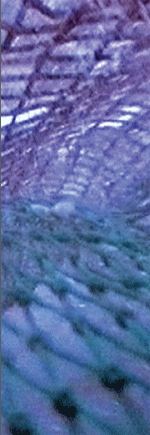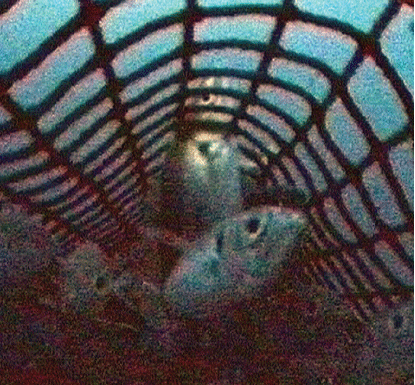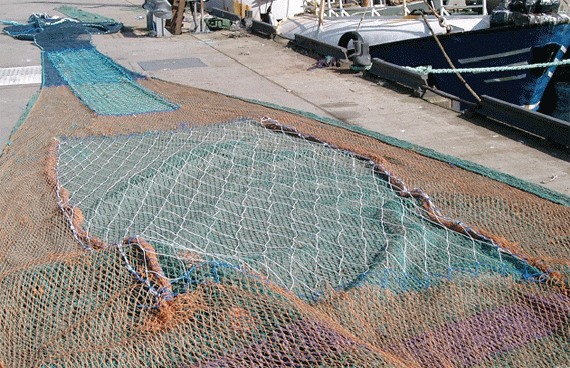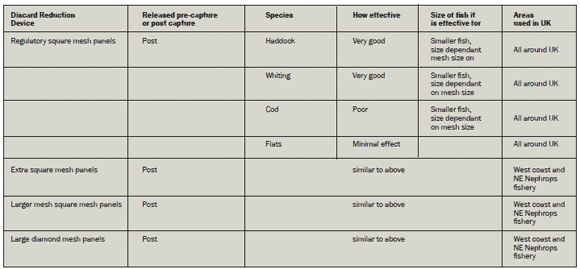
We all know there are big challenges ahead for the fishing industry in stepping up efforts to reduce discards. With the increasing importance of social, economic and political factors as a big part of the issue Seafish gear trial work over the last 15 years is increasingly relevant and is now being rolled out in commercial fisheries.
One of the most common and well known ‘devices’ is the square mesh panel, a method of ensuring the meshes in the panel remain fully open throughout the fishing operation, to allow for the release of small fish.
In a standard trawl constructed from normal diamond mesh, without a square mesh panel, the mesh opening, in the area of the fishing circle, will only be about 30-40% of the mesh length.
This means that a 100mm long mesh will only be open to about 30-40mm at its widest point, which is not a very big area for fish to escape from. The meshes further down the net may only be open to about 20% of the mesh length (20mm for 100mm mesh or 16mm for 80mm mesh) in the codend and extension, and this figure can be as low as 10% of the mesh length.
With modern high powered vessels towing the gear faster, and at a more consistent speed, this mesh opening will be maintained throughout the duration of the tow in all but the poorest weather. There is not much chance of escape for small fish!
Square mesh or T45 mesh (mesh turned through 45 degrees) however will maintain its open shape the entire time it is in the water, providing an escape area for the smaller fish. However they can only escape through the square mesh if;
- they find open meshes;
- they have a stimulus to escape through open meshes;
- they are exposed to them for long enough time;
- they have the energy to escape through them.
The standard square mesh panel used in UK fisheries is 3m long (2m for lower powered vessels). This is fitted at the end of the tapered section of the trawl, or in the parallel extension.
In this area the cross section of the trawl will be oval in shape, with a maximum width of about 500mm and a height in the region of 350mm, allowing most of the fish exposure to the panel, but in a very confined space.
However, with modern vessels towing in the region of three knots, a fish is only exposed to the square mesh panel for two to three seconds.
This is not much time for a fish that is already fatigued from being herded into the trawl, and stressed from travelling down from the mouth of the trawl, to find the escape route and actually escape through it.
Effectiveness of mesh panels
Despite this, the regulatory square mesh panels in UK fisheries can reduce catches of small haddock and whiting by as much as 75%. They do not have the same effect on cod, as cod do not possess the same stimulus to escape by rising up in the water column.
The effectiveness of a square mesh panel at releasing small fish can vary and depends on a number of criteria such as: the clarity of the water; daylight or darkness; depth of water; colour and type of netting used; twine thickness; how it is fitted into the trawl; speed of water flow through the trawl; size of fish; and whether the fish are passing down the trawl in groups or as a steady flow of individuals.
By using larger mesh sizes, thinner twine or increasing the area of a square mesh panel more small fish will be released.
Many fishermen are already using larger mesh than required by regulation. It is not so easy to decrease twine thickness due to the need to maintain strength and prevent stretch. More recently many skippers have been experimenting with a second square mesh panel, of a much larger mesh size, further forward in the trawl in an attempt to reduce their discard rates.
Some have tried fitting square mesh with as large as 300mm mesh almost right up to the fishing circle of the trawl, but have found that although these do work to a certain extent they are not as good as expected, only releasing about 30% of the haddock and whiting and having very little effect on cod catches.
This could be for several reasons. The fish are stimulated by the approaching bosom of the trawl to rise up and attempt to escape this danger by swimming ahead and over the headline. If they don’t succeed in doing this, they will then pass down the body of the trawl, where the secondary square mesh panels are situated. They will not have any awareness that they are trapped, so are not stimulated to try to escape until the trawl narrows close to where the regulation square mesh panel is fitted.

Fitting square mesh panels
Generally it is only the fish that are in close proximity to the top large square mesh panel as they pass down the trawl that will attempt to escape through it. The fitting of these square mesh panels closer to the front of the trawl can require a bit of thought, as the diamond meshes in this area will be more open than in the extension. Estimating the actual mesh opening, and there by the mesh length at this opening, can be extremely difficult. There is no easy solution, as the actual mesh opening will vary according to trawl design and several other criteria. If there is a length differential between the diamond and the square mesh it could well affect the fishing efficiency of the trawl. If the square mesh panel is made too wide, in relation to the number of diamond meshes across and their presumed opening, the panel will tend to ‘concertina’ and make it difficult for any fish to escape through it. To prevent the possibility of these problems it is easier to fit large mesh diamond mesh panels in this area.
Options for fitting square mesh panels will be covered in the next article including in the belly of the trawl, cod ends and extensions and large diamond mesh panels.


March 2012
Further Reading
| |
- | Go to our previous news item on this story by clicking here. |

